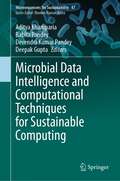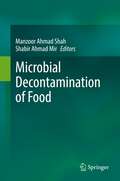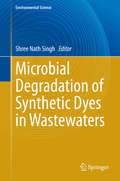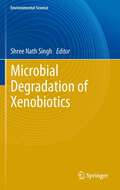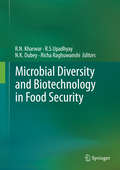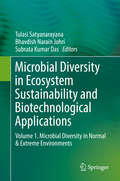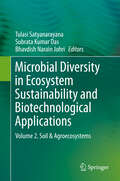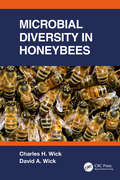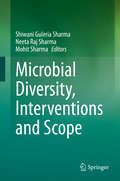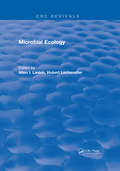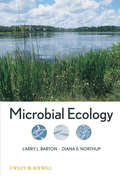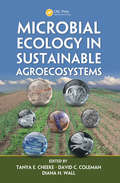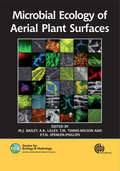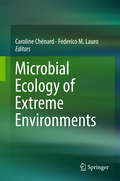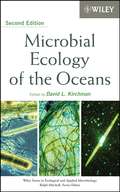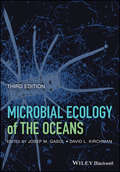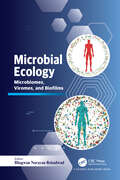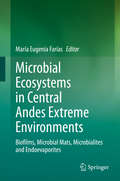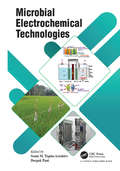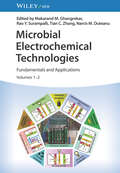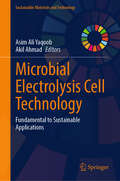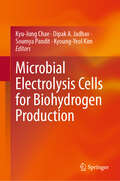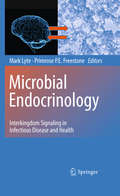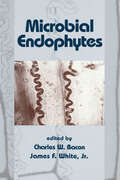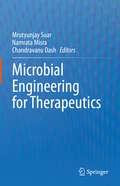- Table View
- List View
Microbial Data Intelligence and Computational Techniques for Sustainable Computing (Microorganisms for Sustainability #47)
by Deepak Gupta Aditya Khamparia Babita Pandey Devendra Kumar PandeyThis book offers information on intelligent and computational techniques for microbial data associated with plant microbes, human microbes etc. The main focus of this book is to provide an insight on building smart sustainable solutions for microbial technology using intelligent computational techniques. Microbes are ubiquitous in nature, and their interactions among each other are important for colonizing diverse habitats. The core idea of sustainable computing is to deploy algorithms, models, policies and protocols to improve energy efficiency and management of resources, enhancing ecological balance, biological sustenance and other services on societal contexts. Chapters in this book explore the conventional methods as well as the most recently recognized high-throughput technologies which are important for productive agroecosystems to feed the growing global population. This book is of interest to teachers, researchers, microbiologist, computer bioinformatics scientists,plant and environmental scientist, and those interested in environment stewardship around the world. The book also serves as an advanced textbook material for undergraduate and graduate students of computer science, biomedicine, agriculture, human science, forestry, ecology, soil science, and environmental sciences and policy makers.
Microbial Decontamination of Food
by Manzoor Ahmad Shah Shabir Ahmad MirFood is contaminated in the production chain and is the point of concern among the consumers and industries. There is also a considerable increase in foodborne outbreaks, which possess the challenge to industry associated with the production of processed food. Various strategies are used to prevent the contamination during postharvest stage, storage and distribution. Different methods are exploited for degrading or eliminating the microbial contamination from food commodities. The conventional techniques used for decontamination demanded a considerable requirement for novel technologies, which are efficient, environmental friendly, and cost-effective. Novel technologies efficiently remove the contamination without adversely affecting the nutritional properties and sensory characteristics of food material. There is a lack of scientific information on the microbial decontamination of different food commodities such as fruits, vegetables, cereals, sprouts, microgreens, meat, poultry, milk, nut, spices etc. under one umbrella. The application of conventional and novel technologies for improving the food safety of individual food commodities will be addresses in this book. Written by several experts in the field, this book is a valuable source for students, scientists, and professionals in food science, food microbiology, food technology, food processing, and other allied sciences.
Microbial Degradation of Synthetic Dyes in Wastewaters
by Shree Nath SinghToday synthetic dyes are used extensively in the textile dyeing, paper printing, color photography, pharmaceuticals, food and drink, cosmetic and leather industries. As of now, over 100,000 different dyes are available, with an annual production of over 700,000 metric tons. These industries discharge an enormous amount of colored effluents into natural water bodies, with or without treatment. The textile industry alone discharges 280,000 tons of dyes every year, making it the largest contributor to colored effluent discharge. Although a variety of treatment technologies are available, including adsorption, chemical oxidation, precipitation, coagulation, filtration electrolysis and photodegradation, biological and microbiological methods employing activated sludge, pure cultures, microbial consortia and degradative enzymes are economically viable, effective and environmentally responsible options. As such, this book gathers review articles from international experts working on the microbial degradation of synthetic dyes, offering readers the latest information on the subject. It is intended as a quick reference guide for academics, scientists and industrialists around the world.
Microbial Degradation of Xenobiotics
by Shree Nath SinghOur interest in the microbial biodegradation of xenobiotics has increased many folds in recent years to find out sustainable ways for environmental cleanup. Bioremediation and biotransformation processes harness the naturally occurring ability of microbes to degrade, transform or accumulate a wide range of organic pollutants. Major methodological breakthroughs in recent years through detailed genomic, metagenomic, proteomic, bioinformatic and other high-throughput analyses of environmentally relevant microorganisms have provided us unprecedented insights into key biodegradative pathways and the ability of organisms to adapt to changing environmental conditions. The degradation of a wide spectrum of organic pollutants and wastes discharged into the environment by anthropogenic activities is an emerging need today to promote sustainable development of our society with low environmental impact. Microbial processes play a major role in the removal of recalcitrant compounds taking advantage of the astonishing catabolic versatility of microorganisms to degrade or transform such compounds. New breakthroughs in sequencing, genomics, proteomics, bioinformatics and imaging are generating vital information which opens a new era providing new insights of metabolic and regulatory networks, as well as clues to the evolution of degradation pathways and to the molecular adaptation strategies to changing environmental conditions. Functional genomic and metagenomic approaches are increasing our understanding of the relative importance of different pathways and regulatory networks to carbon flux in particular environments and for particular compounds. New approaches will certainly accelerate the development of bioremediation technologies and biotransformation processes in coming years for natural attenuation of contaminated environments
Microbial Diversity and Biotechnology in Food Security
by R. S. Upadhyay R. N. Kharwar N. K. Dubey Richa RaghuwanshiThe roles of microbes in agriculture, industry and environment have been the point of interest since long time for their potential exploitation. Although only a fraction of microbial diversity was accessed by microbiologists earlier for harnessing them owing to limited techniques available. The molecular techniques have opened new vistas to access the wide field of the unexplored microbes and their exploitation for useful genes and novel metabolites. Sincere efforts have been made in biotechnology using microbes leading to improve our life with respect to agriculture and people health. This comprehensive volume covers different aspects of microbial biotechnology and its management in sustainable agriculture for food security and improved human health. The book comprises four sections: Endophytes and Mycorrhizae, Microbial Diversity and Plant Protection, Microbial Functions and Biotechnology, and Microbes and the Environment, which contain 53 chapters. The book examines the aspects on endophytes and mycorrhizae, bioactive compounds, growth promoting microorganisms, disease management with emphasis on biocontrol, genetics of disease resistance, microbial enzymes, advances in potential of microbes and their industrial as well as pharmaceutical applications. In addition, the use of botanicals, and the etiology and management of medicinal and aromatic plants in the post harvest management have been reviewed in greater depth for the benefit of teaching and research community The biotechnological developments using microbe potential have enabled us combat the environment and human health problems worldwide in ecofriendly manner. We are sure that this volume will be highly useful to all those concerned with fungi, bacteria, viruses and their biology, including environmental and public health officers and professionals in the field of interest. The volume is an exhaustive coverage of almost all the aspects of microbial biology and biotechnology.
Microbial Diversity in Ecosystem Sustainability and Biotechnological Applications: Volume 1. Microbial Diversity in Normal & Extreme Environments
by Bhavdish Narain Johri Tulasi Satyanarayana Subrata Kumar DasThis book discusses microbial diversity in various habitats and environments, its role in ecosystem maintenance, and its potential applications (e.g. biofertilizers, biocatalysts, antibiotics, other bioactive compounds, exopolysaccharides etc.). The respective chapters, all contributed by renowned experts, offer cutting-edge information in the fields of microbial ecology and biogeography. The book explains the reasons behind the occurrence of various biogeographies and highlights recent tools (e.g. metagenomics) that can aid in biogeography studies by providing information on nucleic acid sequence data, thereby directly identifying microorganisms in various habitats and environments. In turn, the book describes how human intervention results in depletion of biodiversity, and how numerous hotspots are now losing their endemic biodiversity, resulting in the loss of many ecologically important microorganisms. In closing, the book underscores the importance of microbial diversity for sustainable ecosystems.
Microbial Diversity in Ecosystem Sustainability and Biotechnological Applications: Volume 2. Soil & Agroecosystems
by Bhavdish Narain Johri Tulasi Satyanarayana Subrata Kumar DasThis volume comprehensively reviews recent advances in our understanding of the diversity of microbes in various types of terrestrial ecosystems, such as caves, deserts and cultivated fields. It is written by leading experts, and highlights the culturable microbes identified using conventional approaches, as well as non-culturable ones unveiled with metagenomic and microbiomic approaches. It discusses the role of microbes in ecosystem sustainability and their potential biotechnological applications. The book further discusses the diversity and utility of ectomycorrhizal and entomopathogenic fungi and yeasts that dwell on grapes, it examines the biotechnological applications of specific microbes such as lichens, xylan- and cellulose-saccharifying bacteria and archaea, chitinolytic bacteria, methanogenic archaea and pathogenic yeasts.
Microbial Diversity in Honeybees
by Charles H. Wick David A. WickHoneybees are an important link in our food chain because they are major pollinators of food crops. In recent years, honeybee populations have declined precipitously perhaps due to changes in their microbiome. This book describes and identifies the bee microbiome using a proteomics technology. Chapters include the detection and identification of microbes found in honeybees collected around the United States. This book contains new data and illustrates the rich diversity of microbes as collected by honeybees. It is a must read for everyone concerned about the honeybee and working in the industry.
Microbial Diversity, Interventions and Scope
by Neeta Raj Sharma Shiwani Guleria Sharma Mohit SharmaThis book focuses on the application of microbes in all fields of biology. There is an urgent need to understand and explore new microbes, their biological activities, genetic makeup and further opportunities for utilizing them. The book is divided into sections, highlighting the application of microbes in agriculture, nanotechnology, genetic engineering, bioremediation, industry, medicine and forensic sciences, and describing potential future advances in these fields. It also explores the potential role of microbes in space and how they might support life on a different planet.
Microbial Ecology
by Allen I. LaskinThe essays that comprise this anthology of the best in ecology from Critical Reviews in Microbiology describe principles and practices in considerable detail. There is no attempt, however at a balanced presentation of the different groups of microorganisms or their activities. Likewise, some areas of current concern are considered cursorily and others not at all. Nevertheless, the book is an interesting and informative introduction to a growing endeavour. The combined experience and insight of the contributing authors will surely aid the reader to develop an ecological attitude, and to better appreciate microorganisms as determinants of environmental quality.
Microbial Ecology
by Diana E. Northup Larry L. BartonThis book covers the ecological activities of microbes in the biosphere with an emphasis on microbial interactions within their environments and communitiesIn thirteen concise and timely chapters, Microbial Ecology presents a broad overview of this rapidly growing field, explaining the basic principles in an easy-to-follow manner. Using an integrative approach, it comprehensively covers traditional issues in ecology as well as cutting-edge content at the intersection of ecology, microbiology, environmental science and engineering, and molecular biology.Examining the microbial characteristics that enable microbes to grow in different environments, the book provides insights into relevant methodologies for characterization of microorganisms in the environment. The authors draw upon their extensive experience in teaching microbiology to address the latest hot-button topics in the field, such as:Ecology of microorganisms in natural and engineered environmentsAdvances in molecular-based understanding of microbial phylogeny and interactionsMicrobially driven biogeochemical processes and interactions among microbial populations and communitiesMicrobial activities in extreme or unusual environmentsEcological studies pertaining to animal, plant, and insect microbiologyMicrobial processes and interactions associated with environmental pollutionDesigned for use in teaching, Microbial Ecology offers numerous special features to aid both students and instructors, including:Information boxes that highlight key microbial ecology issues"Microbial Spotlights" that focus on how prominent microbial ecologists became interested in microbial ecologyExamples that illustrate the role of bacterial interaction with humansExercises to promote critical thinkingSelected reading listsChapter summaries and review questions for class discussionVarious microbial interactions and community structures are presented through examples and illustrations. Also included are mini case studies that address activities of microorganisms in specific environments, as well as a glossary and key words. All these features make this an ideal textbook for graduate or upper-level undergraduate students in biology, microbiology, ecology, or environmental science. It also serves as a highly useful reference for scientists and environmental professionals.PowerPoint slides of figures from the book are available for download at: ftp://ftp.wiley.com/public/sci_tech_med/microbial_ecology
Microbial Ecology in Sustainable Agroecosystems (Advances in Agroecology)
by David C. Coleman Diana H. Wall Tanya E. CheekeWhile soil ecologists continue to be on the forefront of research on biodiversity and ecosystem function, there are few interdisciplinary studies that incorporate ecological knowledge into sustainable land management practices. Conventional, high fossil-fuel input-based agricultural systems can reduce soil biodiversity, alter soil community structu
Microbial Ecology of Aerial Plant Surfaces
by M. J. Bailey A. K. Lilley T. M. Timms-Wilson P. T. N. Spencer-PhillipsAll aerial plant surfaces, including leaves, stems and flowers are inhabited by diverse assemblages of microorganisms, including filamentous fungi, yeasts, bacteria, and bacteriophages. These organisms have profound effects on plant health and thus impact on ecosystem and agricultural functions. This book is based on proceedings from the 8th International Symposium on the mircobiology of aerial plant surfaces, held in Oxford University in 2005. This is a five yearly conference which brings together international scientists and provides a unique opportunity to discuss developments in this field.
Microbial Ecology of Extreme Environments
by Caroline Chénard Federico M. LauroThis book explores microbial lifestyles, biochemical adaptations, and trophic interactions occurring in extreme environments. By summarizing the latest findings in the field it provides a valuable reference for future studies. Spark ideas for biotechnological and commercial exploitation of microbiomes at the extremes of life are presented. Chapters on viruses complement this highly informative book. In a vertical journey through the microbial biosphere it covers aspects of cold environments, hot environments, extreme saline environments, and extreme pressure environments, and more. From the deep sea, through polar deserts, up to the clouds in the air - the diversity of microbial life in all habitats is described, explored, and comprehensively reviewed. Possible biotechnical applications are discussed. This book aims to provide a useful reference for those who want to start a research program in extreme microbiology and, hopefully, inspire new research directions.
Microbial Ecology of the Oceans
by David L. Kirchman"I would strongly recommend it for library purchase and the reading list of advanced students in this field."--Microbiology Today, May 2009Nearly a decade since its landmark publication, this book has been thoroughly revised in this valuable new editionLike the successful first edition, Microbial Ecology of the Oceans, Second Edition is unique and fills a void in the rapidly growing fields of marine microbiology, microbial ecology, and microbial oceanography. Here, a carefully selected team of international experts explores issues of enduring importance to microbial ecologists, including:Genomes and metagenomes of marine microbesMicrobial evolution, as revealed by molecular techniquesMicrobes in carbon budgets and cyclesViruses and grazers of bacteriaMicrobes and N cycle reactions in sedimentsThe role of microbes in food web dynamicsBiogeochemical cycles in the oceanIn addition to drawing on the long history of microbiology, the contributors also include discussions of the latest advances in biological and chemical oceanography to examine the role of microbes and viruses in the oceans.Richly illustrated with black-and-white photographs and drawings, and complemented with a comprehensive list of additional reading for each chapter, this important new edition provides readers with current information in the fields of marine microbiology and microbial ecology. It is designed for students and researchers in biological and chemical oceanography, geochemistry, marine chemistry, freshwater ecology, and general microbiology. It is also appropriate for professionals and advanced students in related fields.
Microbial Ecology of the Oceans
by David L. Kirchman Josep M. GasolThe newly revised and updated third edition of the bestselling book on microbial ecology in the oceans The third edition of Microbial Ecology of the Oceans features new topics, as well as different approaches to subjects dealt with in previous editions. The book starts out with a general introduction to the changes in the field, as well as looking at the prospects for the coming years. Chapters cover ecology, diversity, and function of microbes, and of microbial genes in the ocean. The biology and ecology of some model organisms, and how we can model the whole of the marine microbes, are dealt with, and some of the trophic roles that have changed in the last years are discussed. Finally, the role of microbes in the oceanic P cycle are presented. Microbial Ecology of the Oceans, Third Edition offers chapters on The Evolution of Microbial Ecology of the Ocean; Marine Microbial Diversity as Seen by High Throughput Sequencing; Ecological Significance of Microbial Trophic Mixing in the Oligotrophic Ocean; Metatranscritomics and Metaproteomics; Advances in Microbial Ecology from Model Marine Bacteria; Marine Microbes and Nonliving Organic Matter; Microbial Ecology and Biogeochemistry of Oxygen-Deficient Water Columns; The Ocean’s Microscale; Ecological Genomics of Marine Viruses; Microbial Physiological Ecology of The Marine Phosphorus Cycle; Phytoplankton Functional Types; and more. A new and updated edition of a key book in aquatic microbial ecology Includes widely used methodological approaches Fully describes the structure of the microbial ecosystem, discussing in particular the sources of carbon for microbial growth Offers theoretical interpretations of subtropical plankton biogeography Microbial Ecology of the Oceans is an ideal text for advanced undergraduates, beginning graduate students, and colleagues from other fields wishing to learn about microbes and the processes they mediate in marine systems.
Microbial Ecology: Microbiomes, Viromes, and Biofilms
by Bhagwan Narayan RekadwadThis book highlights the hidden world of microbiomes, viromes, and biofilms on and inside humans. Our bodies have microbiomes, which contain various bacterial communities, and viromes, which contain viruses. These invisible residents are vital to health and sickness. Infections often result from microbiome imbalances. Pathogenic bacteria can outcompete beneficial ones, causing gut dysbiosis and disease. Understanding this interaction allows probiotics to restore balance and fight infections. Microbes have a major impact on the gut-brain axis. Gut bacteria affect mood, behavior, and neurodegenerative illnesses by producing neurotransmitters and influencing brain development. The "diabesity" relationship to microbiome changes underscores its relevance in metabolic illnesses like diabetes and NAFLD. The microbiota can also affect cancer progression. Specific bacterial strains may promote tumor growth or prevent metastasis, enabling microbiome-based cancer treatments. Probiotics—live bacteria—have enormous potential. Beneficial strains can improve intestinal balance, fight infections, and treat diabetes and autoimmune conditions.Fecal transplants or co-sleeping may modify microbial ecosystems and health effects. Microbiomes, viromes, and biofilms are complex, requiring advanced tools. The makeup, function, and interactions of these communities can be characterized using next-generation sequencing (NGS). As NGS technology advances, researchers explore this hidden world, offering a future where microbiome manipulation underpins customized therapy and preventive healthcare. This area has great potential for understanding health, improving well-being, and fighting diseases in innovative ways.
Microbial Ecosystems in Central Andes Extreme Environments: Biofilms, Microbial Mats, Microbialites and Endoevaporites
by María Eugenia FaríasThe Central Andean Altiplane represents a unique extreme environment due to its high altitude, closed basins that modulate the salt pans and saline wetlands surrounded by deserts, as well as the considerable influence of volcanic activity. UV radiation, arsenic content, high salinity, alkalinity and low dissolved oxygen levels, together with extreme daily temperature fluctuations and oligotrophic conditions, shape an environment that resembles the early Earth and, even more, extraterrestrial conditions. By developing simple biofilms stratified microbial mats or complex microbialites, extreme microbial ecosystems, colonize and thrived in different environments like salt flats, wetlands, lakes volcano vents, geysers and deserts. This book presents our current understanding of these amazing ecosystems, providing a basis for their protection and sustainable utilization. The main audience for this book included researchers and graduate students as well as professionals working in the government, mining industry and similar activities.
Microbial Electrochemical Technologies
by Deepak Pant Sonia Tiquia-ArashiroThis book encompasses the most updated and recent account of research and implementation of Microbial Electrochemical Technologies (METs) from pioneers and experienced researchers in the field who have been working on the interface between electrochemistry and microbiology/biotechnology for many years. It provides a holistic view of the METs, detailing the functional mechanisms, operational configurations, influencing factors governing the reaction process and integration strategies. The book not only provides historical perspectives of the technology and its evolution over the years but also the most recent examples of up-scaling and near future commercialization, making it a must-read for researchers, students, industry practitioners and science enthusiasts. Key Features: Introduces novel technologies that can impact the future infrastructure at the water-energy nexus. Outlines methodologies development and application of microbial electrochemical technologies and details out the illustrations of microbial and electrochemical concepts. Reviews applications across a wide variety of scales, from power generation in the laboratory to approaches. Discusses techniques such as molecular biology and mathematical modeling; the future development of this promising technology; and the role of the system components for the implementation of bioelectrochemical technologies for practical utility. Explores key challenges for implementing these systems and compares them to similar renewable energy technologies, including their efficiency, scalability, system lifetimes, and reliability.
Microbial Electrochemical Technologies: Fundamentals and Applications
by Rao Y. Surampalli Tian C. Zhang Makarand M. Ghangrekar Narcis M. DuteanuA one-stop guide to the future of sustainable energy production The search for sustainable energy sources powered by renewable, non-fossil fuel resources is one of the great scientific challenges of the era. Microorganisms such as bacteria and algae have been shown to function as the basis of a microbial fuel cell, which can operate independently of an electrical power grid on the basis of renewable feed sources. These fuel cells have shown applications ranging from powering implantable biomedical devices to purifying rural water sources, and many more. Microbial Electrochemical Technologies offers a one-stop shop for researchers and developers of technologies incorporating these microbial fuel cells. Beginning with the fundamental processes involved in microbial energy production and the key components of a bioelectrochemical system (BES), it then surveys the major BES types and crucial aspects of technological development and commercialization. The result is an indispensable introduction to these vital power sources and their myriad applications. Microbial Electrochemical Technologies readers will also find: Detailed treatment of BES types including fuel cells, electrolysis and electrosynthesis cells, and more Discussion of commercialization aspects including modelling, performance analysis, and life cycle assessment An authorial team with decades of combined experience on three continentsMicrobial Electrochemical Technologies is a useful reference for electrochemists, microbiologists, biotechnologists, and bioengineers.
Microbial Electrolysis Cell Technology: Fundamental to Sustainable Applications (Sustainable Materials and Technology)
by Akil Ahmad Asim Ali YaqoobThis book covers the different aspects of microbial electrolysis cell (MEC) technology and its applications in wastewater treatment such as nutrient recovery and heavy metals removal. The MEC technique is related to the technique the microbial fuel cells (MFC);, while the MFC uses the microbial decomposition of organic molecules to generate an electric current, MEC partly reverses the process by using an electric current to generate hydrogen or methane from organic material. If a sustainable energy source is used to generate the electric current, the generated hydrogen or methane can be used in an internal combustion engine or PEM fuel cell to generate energy. The chapters in this book describe the basic principles and working mechanism of the MEC, its effectiveness depending on the kind of microorganisms present, type of electrode materials, use of catalysis, and lastly its potential industrial applications for environmental remediation. This book benefits students, young researchers, academicians, and industrial scientists who are working in the field of environmental pollutants and their safe removal using new technologies.
Microbial Electrolysis Cells for Biohydrogen Production
by Soumya Pandit Kyu-Jung Chae Dipak A. Jadhav Kyoung-Yeol KimThis book covers microbial electrolysis cells (MEC) for biohydrogen production and explores the basics, challenges, limitations and applications of this technology. The latest advances in electrochemical reactors and microbial electrochemical systems are also presented, accompanied by a discussion on the way forward towards practical use of MEC technology. Divided into 3 parts, the book commences with an introduction to the fundamentals of microbial electrolysis cells and biohydrogen production, followed by an overview of the latest advances in microbial electrolysis cell research, with particular attention given to the performance and operating conditions. The third part of this book is devoted to MEC scaling-up, were readers will find the recent progresses in the field. The possibilities and challenges of integrating conventional wastewater treatment systems with MEC, commercialization challenges of MECs, and life cycle assessment of MEC for biohydrogen production are alsodiscussed in this part of the book. In this book, readers will also find useful case studies detailing pilot-scale applications of MEC for industrial wastewater treatment. Given its breadth, this book is a valuable resource for scholars in the energy domain, policymakers and researchers actively working with MEC applications. Furthermore, it also appeals to early-stage researchers and scientists interested in the dynamics of microbial electrolysis for wastewater treatment, biohydrogen generation and resource recovery from wastewater.
Microbial Endocrinology
by Mark Lyte Primrose P.E. FreestoneMicrobial endocrinology represents a newly emerging interdisciplinary field that is formed by the intersection of the fields of neurobiology and microbiology. This book will introduce a new perspective to the current understanding not only of the factors that mediate the ability of microbes to cause disease, but also to the mechanisms that maintain normal homeostasis. The discovery that microbes can directly respond to neuroendocrine hormones, as evidenced by increased growth and production of virulence-associated factors, provides for a new framework with which to investigate how microorganisms interface not only with vertebrates, but also with invertebrates and even plants. The reader will learn that the neuroendocrine hormones that one most commonly associates with mammals are actually found throughout the plant, insect and microbial communities to an extent that will undoubtedly surprise many, and most importantly, how interactions between microbes and neuroendocrine hormones can influence the pathophysiology of infectious disease.
Microbial Endophytes
by James F. White Charles W. BaconExamining intercellular infections in certain plant species that lead to a symbiotic relationship between the host and its endophytic microbes, this volume demonstrates the ability of many types of endosymbionts, acting as a unit with hosts to better survive, compete and reproduce. Practical applications of such endophytes are also discussed, for e
Microbial Engineering for Therapeutics
by Mrutyunjay Suar Namrata Misra Chandravanu DashThis book highlights the recent advances in the field of microbial engineering and its application in human healthcare. It underscores the systemic and synthetic biology approaches for engineering microbes and discusses novel treatments for inflammatory bowel diseases based on engineered probiotics. The book also reviews the different options and methods for engineering microbes, ranging from recombinant DNA technology to designing microbes for targeting specific sites and delivering therapeutics. Further, it discusses genetically engineered microorganisms for smart diagnostics and describes current approaches in microbial gene editing using CRISPR-Cas9-based tools. Lastly, it summarizes the potential applications of human microbiome engineering in improving human health and explores potential strategies for scaling-up the production of engineered microbial strains for commercial purposes, as well as the challenges. Given its scope, this book is a valuable resource for students, researchers, academics and entrepreneurs interested in understanding microbial engineering for the production of commercial products.
